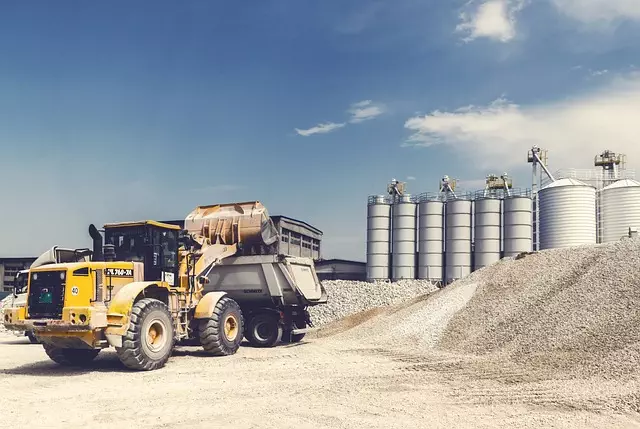Construction ergonomics, a key component of industrial hygiene, focuses on enhancing productivity while safeguarding workers through optimal interaction between employees, their environment, and equipment. This involves identifying hazards (e.g., heavy lifting, chemical exposure), conducting risk assessments, implementing control measures like engineering controls and safe work practices, and monitoring worker exposure to hazardous substances over time. Effective practices also prioritize strain reduction, work-rest cycles, and suitable tool fit. By combining hazard recognition, assessment, exposure monitoring, and ergonomic solutions, construction sites can foster a safety-first culture, reduce musculoskeletal disorders, and ensure industrial hygiene compliance. Technology advancements like wearable sensors and AI algorithms further enhance site safety and worker health.
Construction ergonomics is a critical field focused on optimizing worker safety and comfort through the systematic application of ergonomic principles in construction environments. This comprehensive guide delves into key aspects, including industrial hygiene, hazard recognition and assessment, and exposure monitoring. By understanding these fundamentals, construction professionals can identify and mitigate risks effectively, fostering safer working conditions and enhancing overall job satisfaction.
- Understanding Construction Ergonomics: The Foundation of Worker Safety
- Industrial Hygiene in Construction: Identifying and Controlling Hazards
- Hazard Recognition and Assessment: A Step-by-Step Guide for Construction Sites
- Exposure Monitoring Techniques: Ensuring Safe Working Conditions
- Common Construction Ergonomic Issues and Their Solutions
- Best Practices for Implementing Ergonomic Principles on Site
- The Role of Technology in Enhancing Construction Ergonomics
Understanding Construction Ergonomics: The Foundation of Worker Safety
Understanding Construction Ergonomics: The Foundation of Worker Safety
Construction ergonomics is a critical aspect of industrial hygiene that focuses on optimizing the interaction between workers, their environment, and equipment to enhance productivity while minimizing risks and injuries. By applying principles of ergonomic design and hazard recognition and assessment, construction sites can create safer working conditions. This involves identifying potential hazards in various tasks, such as heavy lifting, repetitive motions, or exposure to dangerous substances. Once these hazards are recognized, comprehensive risk assessments help determine the level of exposure and implement effective control measures.
Effective ergonomic practices go beyond simple task analysis. They encompass strategies for reducing physical strain, improving work-rest cycles, and ensuring proper tool and equipment fit. Regular exposure monitoring is essential to track worker exposure levels to hazardous substances or conditions over time. This data informs adjustments in workplace design, procedures, and personal protective equipment (PPE) to foster a culture of safety where construction workers can perform their duties without undue risk of injury or illness.
Industrial Hygiene in Construction: Identifying and Controlling Hazards
Industrial Hygiene in Construction plays a pivotal role in ensuring worker safety and health. It involves identifying and controlling hazards present on construction sites. The process starts with thorough hazard recognition and assessment, where potential risks like noise, chemicals, falls, or repetitive motions are meticulously identified. Once these hazards are recognized, effective strategies can be implemented to minimize exposure. This includes engineering controls, such as using sound-absorbing materials to reduce noise levels, or implementing safe work practices to prevent falls.
Exposure monitoring is another crucial aspect of industrial hygiene. Regular testing and assessment help determine the levels of hazardous substances in the air or on surfaces. By keeping a close eye on these factors, construction professionals can ensure that workers are not exposed beyond safe limits. This proactive approach contributes to creating safer work environments, reducing the risk of occupational diseases, and enhancing overall productivity on construction sites.
Hazard Recognition and Assessment: A Step-by-Step Guide for Construction Sites
Construction sites are bustling environments with various tasks and equipment, making hazard recognition and assessment a critical aspect of ensuring worker safety. The process involves several steps to identify potential risks and evaluate their severity, leading to effective risk mitigation strategies. It starts with thoroughly observing the work environment, identifying activities, materials, and machinery that could pose hazards. This initial step requires professionals to consider physical, chemical, biological, and ergonomic factors. For instance, construction workers might be exposed to harmful dust particles or loud noises from equipment, requiring specific control measures.
Once potential hazards are identified, a detailed assessment is conducted. This involves evaluating the likelihood of exposure and the potential consequences. It includes analysing tasks, work practices, and existing controls. Exposure monitoring is a crucial component, where samples are collected and analysed to measure contaminant levels. This data helps determine if workers’ safety is at risk and guides the implementation of appropriate industrial hygiene controls, such as improved ventilation or personal protective equipment. Effective hazard recognition and assessment enable construction managers to proactively address risks, fostering a safer working environment.
Exposure Monitoring Techniques: Ensuring Safe Working Conditions
Construction sites present unique challenges for maintaining safe working conditions due to various physical demands and potential hazards. Exposure monitoring techniques play a pivotal role in ensuring industrial hygiene and mitigating risks. These methods involve rigorous hazard recognition and assessment, which is the first step towards creating a healthier work environment. By identifying substances or activities that may pose risks, such as noise, vibration, or exposure to dangerous chemicals, employers can implement targeted safety measures.
One of the primary tools in an ergonomist’s arsenal is regular and comprehensive exposure monitoring. This involves taking measurements and samples to quantify workers’ actual level of exposure to potential hazards. Such data enables informed decisions about personal protective equipment (PPE), work practice modifications, or engineering controls to reduce or eliminate risks. Effective exposure monitoring ensures that construction sites adhere to safety standards, promotes worker well-being, and fosters a culture of occupational health and safety.
Common Construction Ergonomic Issues and Their Solutions
Construction sites present unique challenges for worker health and safety, with various ergonomic issues stemming from repetitive tasks, heavy lifting, and confined spaces. One of the primary concerns is musculoskeletal disorders (MSDs), such as back pain, carpal tunnel syndrome, and tendonitis, often caused by improper lifting techniques, inadequate tool design, or prolonged awkward postures. To mitigate these risks, implementing effective industrial hygiene practices is essential. This includes regular hazard recognition and assessment to identify potential ergonomic dangers.
Solutions range from simple modifications like providing ergonomically designed tools and equipment, ensuring proper training in lifting techniques, and offering adjustable workstations. More complex interventions involve layout changes to promote better workflow and reduce physical strain. Additionally, exposure monitoring can help track worker interactions with hazardous materials or environments, enabling employers to take proactive measures. By addressing these issues holistically, construction companies can foster a safer workplace, enhance employee well-being, and improve overall job satisfaction.
Best Practices for Implementing Ergonomic Principles on Site
Implementing ergonomic principles on construction sites is a proactive approach to enhancing worker safety and productivity. Best practices begin with thorough hazard recognition and assessment, identifying potential risks specific to the job site and tasks involved. This includes evaluating physical hazards like heavy lifting, repetitive motions, or exposure to harmful substances, as well as organizational factors such as workspace design and tool layout. Once identified, these hazards can be addressed through tailored interventions.
Ergonomic solutions should focus on controlling and minimizing exposures. Implementing safety protocols, providing personal protective equipment (PPE), and offering regular training sessions on proper lifting techniques and safe work practices are essential. Additionally, exposure monitoring is crucial to measure and track potential risks over time, ensuring that control measures remain effective. By combining these strategies, construction sites can foster a culture of industrial hygiene, prioritizing worker well-being and creating a safer environment for all personnel.
The Role of Technology in Enhancing Construction Ergonomics
In today’s digital era, technology plays a pivotal role in enhancing construction ergonomics, thereby improving site safety and worker health. Advanced tools like wearable sensors and smart devices enable continuous monitoring of physical demands and potential hazards. These innovations facilitate real-time data collection on worker postures, movements, and exposure to harmful substances, such as dust or noise. By leveraging this data, contractors can promptly identify ergonomically risky tasks and implement corrective measures, thus reducing the risk of occupational injuries and illnesses.
Furthermore, technology streamlines hazard recognition and assessment processes. Digital platforms equipped with artificial intelligence (AI) algorithms analyze project blueprints, historical incident reports, and environmental factors to predict potential risks before work begins. This proactive approach to industrial hygiene allows for better preparation and resource allocation, ensuring that safety protocols are in place from the outset. Additionally, exposure monitoring systems, powered by IoT (Internet of Things) technology, help track and quantify worker exposure to various hazards, enabling more precise risk management strategies.


